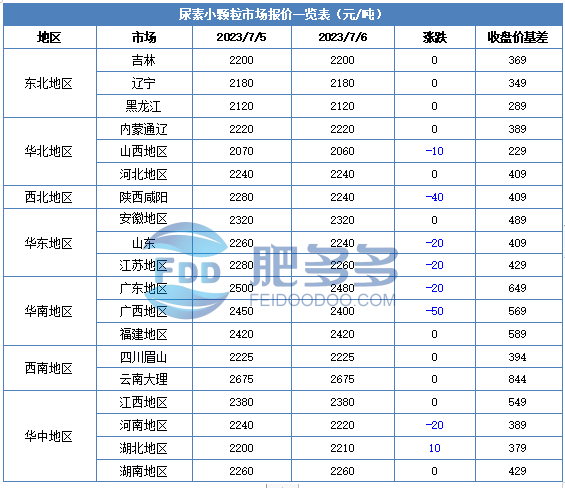- Mall
- Supermarket
- Supplier
- Cross-Border Barter
- Industrial Data
- Warehouse Logistics
- Trade Assurance
- Expo Services
China Urea Price Index:
According to Feiduo data, the urea small pellet price index on July 6 was 2,273.18, down 7.73 from yesterday, down 0.34% month-on-month, and down 21.55% year-on-year.

Urea futures market:
The price of the urea UR2309 contract rose first and then fell today. After the opening of early trading, the futures price fluctuated and rose to a high of 1850. In the afternoon, the futures price fell within a narrow range, maintaining a low and volatile operation, and closed at 1831 in late trading. The opening price of the Urea UR2309 contract: 1815, the highest price: 1850, the lowest price: 1815, the settlement price: 1832, and the closing price: 1831. The closing price increased by 44 compared with the settlement price of the previous trading day, and the month-on-month increase by 0.22%. The daily fluctuation range is 1815-1850, and the spread is 35; The 09 contract has reduced its position by 13137 lots today, and has held 405780 lots so far.
Spot market analysis:
Today, China's urea spot price began to be partially lowered, ranging from 10 to 50 yuan/ton. As terminal demand weakens, downstream replenishment sentiment gradually cools down, and high-priced market transactions are difficult to support. Most companies implement orders to be issued in the early stage and lower their quotations to promote new orders. Enterprise inventories are low, and inventory pressure is not great in the short term. Specifically, prices in Northeast China have stabilized at 2,120 - 2,200 yuan/ton. Prices in North China fell to 2,060 - 2,250 yuan/ton. Prices in Northwest China fell to 2,240 - 2,250 yuan/ton. Prices in Southwest China rose to 2,200 - 2,700 yuan/ton. Prices in East China have stabilized at 2,160 - 2,320 yuan/ton. The price of small and medium-sized particles in Central China fell to 2,210 - 2,380 yuan/ton, and the price of large particles fell to 2,150 - 2,200 yuan/ton. Prices in South China fell to 2,400 - 2,480 yuan/ton.
Market outlook forecast:
In terms of futures, today's futures prices fluctuate within a narrow range compared with yesterday. Observe that the Bollinger Band has three tracks, the middle and lower tracks have strong support, and the futures prices may have an upward trend. Fundamentally speaking, the urea supply side is expected to have 3.8 million tons of production capacity put on the market in the second half of the year. The mentality of the industry is bearish. In the long run, the pressure on urea supply cannot be underestimated. In the short term, the supply will remain sufficient and stable, with a daily output of around 170,000 tons. On the demand side, downstream agricultural demand has gradually slowed down and gradually resisted high prices. In terms of industrial demand, as mentioned above, it mainly relies on factories to support it in the short term. Overall, the negative demand is not obvious, but it affects the recent market. The main factor. To sum up, in the short term, it is inferred that the market situation is fierce between supply and demand, and the market is stable and volatile. In the long run, as demand weakens further, if the situation of oversupply cannot be reversed, it is inevitable that the market will drop. If we look further, in the autumn, there may be a wave of demand, and market enthusiasm for trading may appear for a short time.
